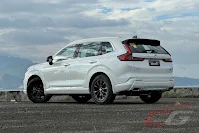If there’s one thing you could say about the Honda CR-V is that it’s comfortable in its own skin. In each of its six generations, there was little need to reinvent the basic recipe. Whereas its competitors all tried to reimagine themselves, this compact SUV stuck to its guns of being a practical, family-friendly compact SUV that happens to be a great all-rounder. This has allowed Honda to carefully refine the formula, improving its strengths, while reducing or eliminating its weaknesses in the process. There’s a Japanese term for that—Kaizen—and the all-new CR-V is an embodiment of that.
Starting with the looks, the all-new CR-V doesn’t introduce some new radical design philosophy. Though Honda uses the term, “Blown Away” to describe the new styling, there’s nothing remotely earth shaking about the way the sixth-gen model looks. Instead, it’s all about imbuing it with a cleaner, more refined aesthetic that’s at tune with the times while still retaining many of the model’s trademark cues. The result? It’s unmistakably a CR-V whether you view it from the front, side, or back. Notably, the CR-V introduces a new Road Sailing or RS variant for the first time. This one sportifies the whole exterior thanks to more painted surfaces and additional black bits. Again, nothing groundbreaking.
The same thing could be said about the all-new CR-V’s interior. It’s pretty much standard Honda fare which is to say, well-built and ergonomic. The general motif is taken from the current-generation Civic, so it has the same mesh detailing that dominates the dashboard, the same 10.2-inch digital gauge cluster, and the same 9-inch screen that juts out at the middle. Offering an easy-to-use driving environment has always been a Honda strong point, and the CR-V continues to deliver in that regard. Getting comfy takes just a few seconds and a couple of adjustments to the power seats (now with memory) and the tilt/telescopic steering wheel. And despite the added tech, Honda’s managed to hit the usability aspect to a tee.
Like its exterior, the CR-V’s cabin isn’t shouty. Instead, it’s all nailing down the finer details. The design itself doesn’t strike you as premium, so if you’re expecting things like Nappa leather or real maple wood trim, you won’t find them here. Instead, the choice of materials strikes you as being born out of actual family usage. It’s about longevity, sturdiness, and durability—that sort of thing. It’s all about offering better material, more supple leather, and crisper switchgear while making sure they’re kid- or pet-proof.
Some criticism leveled against the CR-V has to do with its price. For the first time in its history, the starting price has crept up to P 2.1 million for the base 1.5 V Turbo and going all the way to P 2.590-million for the top-of-the-line 2.0 RS e:HEV. That seems like a lot of money for a compact SUV, but Honda at least increased the specs too. In fact, the 1.5 V Turbo is now a fully-loaded offering with everything but a 360-degree camera, panoramic sunroof, and the Bose speaker system. Those three features are on the 1.5 VX Turbo (360-degree camera) or 2.0 RS e:HEV (panoramic sunroof and Bose speaker system).
Space-wise, there’s nothing to fault with the all-new CR-V. The front seats are extremely generous, but the second row reveals enough space for people to sit with their legs crossed. The seats themselves slightly differ with the 7-seater variants mounted a bit higher (likely to accommodate the tilt-up mechanism) compared to the 5-seater hybrid. Thankfully, this has no effect on the headroom since the 7-seaters don’t have to content with the panoramic sunroof’s mechanism. Onto the third-row, Honda has managed to include many nifty engineering solutions to make the most out of the available space. It won’t match a mid-sized SUV in terms of knee room, but it makes it more hospitable for kids or hobbit-sized adults.
Onto the drive itself, the CR-V continues to show that it’s a capable performer. It’s up to the task on just about anything be it puttering around in the city or cruising on the highway. As with any modestly-sized engine that’s reliant on boost, the 190-horsepower engine requires the turbo to spool to get some pace going. Once it hits the sweet spot, there’s enough grunt to pull around all its weight and four overweight motoring journalists aboard. Thankfully, the CVT is up to the task of keeping the engine singing at the right note.
The real gamechanger here is Honda’s e:HEV system. It behaves like it’s got a built-in cheat code activated all the time. No tight mountain pass is enough to disrupt its rhythm. Even with the same four people aboard, it makes short work of any driving challenge by seamlessly switching between electric mode, engine mode, or a combination of the two. For those who’re curious, almost nothing separates the fuel economy of the 1.5 V and 1.5 VX with the front-wheel drive doing around 14 km/L, while the all-wheel drive doing 13 km/L. The RS e:HEV, meanwhile, does close to 17 km/L. Mind you, these were on a mixed city/highway gunnit conditions.
On the handling aspect, the CR-V is clearly built for the everyday drive. It doesn’t create headlines for its animal-and-person-as-one handling, but there’s still enough stability and precision baked into the steering and chassis to call it “adept” at things enthusiasts look out for. Even better, Honda engineers gifted it with lots of suspension travel and it uses it well enough as not to cause any ruckus over huge dips or potholes. Even at the end of the suspension stroke, it feels sorted. Simply put, it’s smooth; it smothers out the worst of roads excellently. Negatives? Well, road noise is very evident in the turbo versions, especially from the front passenger side. The e:HEV negates that with the clever use of active sound cancellation.
By not messing with its formula, the latest version of the Honda CR-V comes across as a winner. Though it doesn’t necessarily turn heads based on the way it looks nor does it set your loins on fire each time you get behind the wheel, but thanks to Kaizen or continuous improvement, it delivers ultimately on the points that matter. In the greater scheme of things, it’s a practical, well-built, fuel-efficient compact SUV. Like every generation before it, it’s hard to fall head over heels in love with the CR-V, but it’s guaranteed that everyone will find something to like about it.






















How come come you got 13-14 km/ on the 1.5T while most reviews got only around 7-8?
ReplyDeleteIt'll likely drop to around 7-8 km/L in the city. Our first drive had a bit of city, but it was mostly highway (average speed of 64 km/h).
DeleteWhat about the fuel economy of the e:HEV in the city?
DeleteWait for our full review when Honda lends us a CR-V out.
DeleteAre these made in thailand?
ReplyDeleteThailand.
DeleteHi Uly, cant wait for your comparison review with other compact SUVs such as Subaru Forester and Toyota RAV4.
ReplyDeleteJust got CRV Hybrid, filled up with Shell 91 octane left Makati 5:15pm for QC 10km away and arrived 630pm and the computer said the fuel consumption was 10.15KM/L
ReplyDeleteI'm probably in the minority but I think this looks much better than the Mazda cx-60
ReplyDeleteAgree. Esp the pearl white hybrid 🥵
Deletedude that white RS looks so nice <3
ReplyDeleteHow does the hybrid compare on fuel economy vs RAV 4 Hybrid?
ReplyDeleteWe've yet to drive it on roads we're familiar with. We'll have to wait for a thorough test drive to find out the fuel mileage figures.
DeleteImho:
ReplyDeleteIt would be nice if we had 19 inch wheel option (like Indonesian market)